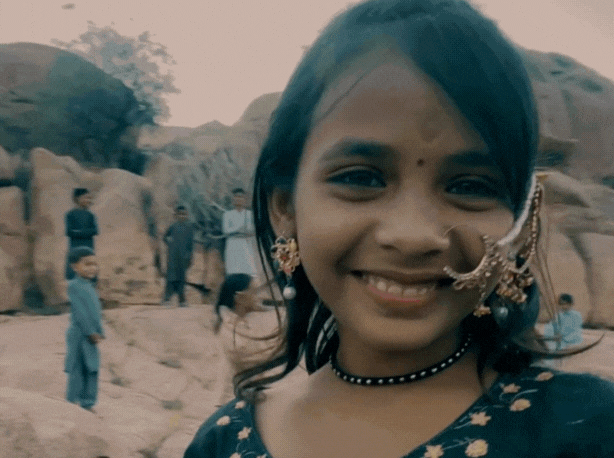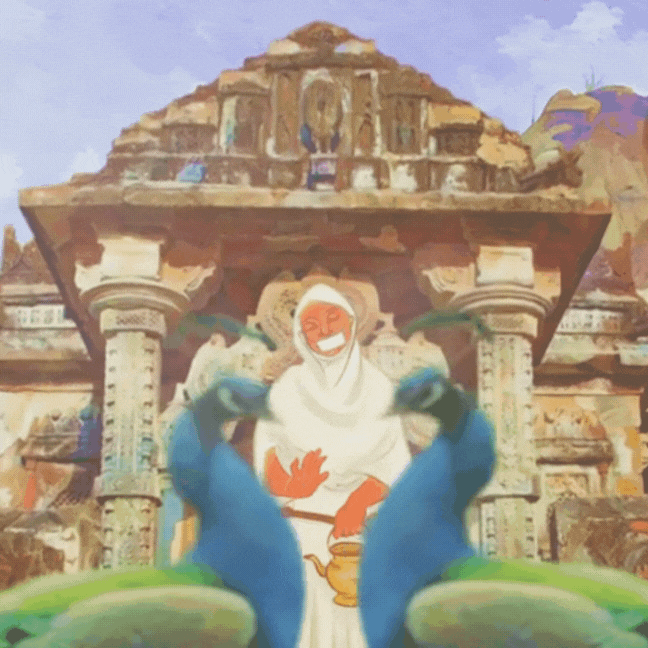Songs for Kalyug
Saif Samejo’s Quiet Defence of Karoonjhar
by Areesha Khuwaja (Pakkhee)
In the contested landscape of Karoonjhar, the work of artist and cultural practitioner Saif Samejo emerges not merely as a call for preservation, but as a critical cultural praxis that challenges the postcolonial logic of resource extraction. His long-standing advocacy, most visibly his campaign for UNESCO World Heritage status and a petition he spearheaded, is an act of institutional critique, repositioning the mountains from a quarry of granite to a repository of living, indigenous knowledge.
The discourse surrounding Karoonjhar’s heritage is itself a site of struggle. The hegemonic narrative of “development” frames the mountains as inert matter, ready for extraction in the name of economic growth. Samejo’s response is a deliberate act of intellectual and cultural resistance, rooted in a deep act of listening to the land. As he wrote in a 2019 opinion piece, “At a glance, every stone is carved by nature in such a way that it feels like a face,” and for locals, the mountains’ destruction is akin to their “own mother’s milk being snatched away.” It's important that we see this not as a poetic flourish but as a politico-cultural position that confronts the legal and economic structures enabling extraction by prioritizing an epistemology derived from the land itself. In naming the mountain as an indivisible entity, he contests the fundamental terms by which the state and market claim the right to disassemble it, not once, but over and over again.

Saif Samejo and Pundit at Shiv Mandir, Nagarparkar - During Echoes of Karoonjhar Artist Residency with Lahooti, Invisible Flock | Supported by British Council
Kalyug as Lived Reality and Counter-Praxis
Pundit Chaturlal, a Lohano priest and one of the last keepers of Nagarparkar’s Jain memory, calls this moment Kalyug, the age of betrayal, where the sacred recedes and guardians (state) become its sellers. In his telling, Kalyug is a long dusk, where inversion of custodianship becomes normalised. In Karoonjhar, the mining of granite makes this inversion concrete: heritage protections exist on paper, yet are undermined by tenders that reduce a revered landscape to raw material.
Samejo’s practice at the Lahooti Karoonjhar Commune offers a direct counter-praxis. Here, the mountains are recontextualized not as a commodity but as a vital cultural text to be engaged with. His work at the commune, re-embeds the land within its cultural and historical narratives. This model of sustainable engagement insists on the mountain’s intrinsic value, bound to the community it sustains.
Pedagogy and Practice at the Commune
For tourists in retreats, the commune offers locally grounded experiences, through food, music, and storytelling, that shift perspectives from viewing Karoonjhar as a picturesque backdrop to understanding it as a living sustainer.This pedagogy deepens in the Echoes of Karoonjhar residency, where artists engage directly with Rajput, Rabari, Kohli, and Meghwar communities, as well as the historical context of the Jain exodus. Samejo acts as a cultural interpreter, ensuring artists understand the human custodians of the land’s memory. Each evening, they listen to a different folk artist, hearing the land’s history and present articulated through melody and breath. In this process, deep listening becomes a deliberate strategy to replace the colonial gaze with an empathetic, reciprocal relationship to land and people.
At the Lahore Biennale Foundation, Samejo shared the genesis of a residency project supported by the British Council, focusing on Karoonjhar’s landscapes and their deep connection to the local communities. He described how the residency brought together artists, musicians, and storytellers to document the region’s folklore, ecology, and traditions. The initiative was not only a cultural celebration but alsoa way to resist the state's plans for mining that threaten the mountain’s ecosystem and local livelihoods. Through art and community engagement, Samejo emphasised fostering a sustainable relationship with Karoonjhar, advocating for its preservation as both a cultural and ecological sanctuary.
In that discussion, he spoke of the significance of folk traditions like oral histories, music, and ecological practices as vital elements of cultural identity. The story of Marvi, the legendary figure who symbolises resistance and devotion to her land, served as a poignant example of how folklore encodes resilience and belonging. He also highlighted the mountain’s ecological role: Karoonjhar’s unique geology enables it to preserve water, sustaining both biodiversity and human life in a fragile desert environment.
This alignment of his life with his work gives his efforts an authenticity that purely academic or distant advocacy can't achieve. He embodies the message that "land and culture are indivisible" through his practice, proving that his life is, in itself, a form of decolonial intervention.
Songs as Acts of Custodianship
Two works from his band, The Sketches exemplify this approach. Adh Qalandar Chhokri, written by poet Aziz Gul and composed by Samejo, maps belonging through the act of naming. Moving through villages, Kaasbo, Choorio, Veera Wah, Saardhro, the poem calls for a girl as sacred as the Gori temple. Haroon Habib’s visuals linger on quiet gestures: a hand brushing hair, children at play, the slow rhythm of daily life. The poet’s question, O girl, as sacred as Gori temple, which country is yours? is not about nationhood. Here, geography is relational, oral, sacred; naming keeps the land alive.
Aman Ji Nagri, written by poet Maru Khushk and performed by The Sketches was created during the Karoonjhar Artist Residency. It is a meditation on harmony. “Even the cattle ask for peace,” the poet writes, reminding us that in this landscape, peace is not policy but a shared pulse between human and non-human life. The still visuals resist spectacle, letting the music carry the weight of a plea from a land that has long been a sanctuary for Jain, Hindu, Muslim, nomadic, and pastoral communities.
These songs are not merely artistic outputs; they are sonic archives. They carry Karoonjhar’s memory beyond its borders without severing it from its roots, demonstrating how music, like the residency itself, can function as both documentation and an act of resistance.
This musical thread also extends into Khumariyoon, Saif’s collaboration with the northern Pakistani band Khumariyan. The piece reinterprets a traditional folk song from Nagarparkar as a musical fusion; an ode to Karoonjhar that carries the mountain’s soundscape into a new register while keeping its roots intact. By bringing the tune into dialogue with Khumariyan’s Pashto-influenced instrumentation, Samejo bridges the cultural geographies of Sindh and the north, asserting that Karoonjhar’s music is not only a local heritage but part of Pakistan’s shared cultural memory.


Screen grabs from Adh Qalandar Chokri Music Video by The Sketches / Saif Samejo |
Filmed by Haroon Habib
Mobilizing the Community
The Lahooti Melo serves as a vital platform for advocacy, transforming cultural performance into mobilisation. A 2024 session, titled Karoonjhar maro maaee baap (“Karoonjhar is like my mother and father”), called for the hills’ preservation as a cultural and religious heritage site. Speakers and performers declared that destroying Karoonjhar was “tantamount to the murder of people’s identity.” With music, drum circles, and placards, the festival pushes back against the tokenisation of culture, re-politicising practice and embedding the defence of Karoonjhar in collective acts of defiance. In a Fluxus sense, this was not a performance about Karoonjhar — it was Karoonjhar’s defence enacted as performance. The drumbeats, placards, and songs dissolved the line between artist and audience, collapsing art into life and life into a collective act of resistance.
From Local Memory to Global Leverage
In Kalyug, the fight for Karoonjhar’s survival is not an economic debate but a question of postcolonial identity, cultural memory, and the political right of a people to protect the breath of their land. Samejo’s multi-faceted practice (his writing, music, commune, and residency) builds a strategic case for World Heritage recognition. This is not simply about prestige; it is a tactical engagement with global frameworks to shield an indigenous history threatened by local and transnational capital.
In this framing, Saif Samejo’s work is not mere preservation; it is a decolonial intervention, where the archive is alive, the pedagogy is reciprocal, and listening with the mountain becomes a refusal of the silence that extraction demands.
How do we build a growing community of friends for Karoonjhar (through art, teaching, and storytelling) so that soon, like Hampi, recognized for its extraordinary sacred landscape and historic architecture, Karoonjhar Hills too become celebrated as a UNESCO World Heritage Site, not just for its ruins, but for its living culture and enduring memory?
Explore Similar Stories

Artist Statement
Areesha Khuwaja (Pakkhee) is a visual ethnographer and artist whose work traces memory, myth, and land-based knowledge through animation, illustration, and storytelling. In Echoes of Karoonjhar, she approaches the mountain not as a symbol, but as an ancestral presence and a living archive shaped by time, ritual, and silence.
Her practice during the residency centered on listening: to wells, to songs, to the subtle gestures that carry collective memory. From the sacred feminine of Jain stories to the poetic resistance of Rajput oral traditions, her work weaves multiple timelines into a visual language that resists disappearance. She is particularly drawn to the women who appear at the edges, like Shamoon Kohli, who dances freely, embodying the mountain’s rhythm without permission or stage.
Through hand-drawn animation, zines, and site-responsive design, Areesha’s contribution to Echoes of Karoonjhar is an invitation to remember what the land already knows. It is a practice of reanimating what has been silenced — with care, with myth, and with deep attention.













